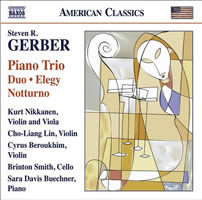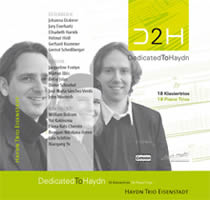Piano Trios
|
Grant Chu Covell [April 2010.] Compared with the string quartet, contemporary piano trios are in short supply. After Ravel, Ives, Shostakovich and perhaps Schnittke, few 20th-century works have become staples. What follows is a collection accumulated over recent years. Perhaps I have old-fashioned tastes. I hear several of the most appealing compositions referring to past exemplars.
“Bulb.” Donnacha DENNEHY: Bulb (2006). Ed BENNETT: for Marcel Dzama (2007). Dierdre GRIBBIN: How to Make the Water Sound (1997). Kevin VOLANS: Piano Trio (2002, rev. 2005, 2007). Fidelio Trio: Mary Dullea (pno), Darragh Morgan (vln), Robin Michael (vlc). NMC D147 (http://www.nmcrec.co.uk/). Distributed in the US by Qualiton (http://www.qualiton.com/). This Irish-themed release offers four exacting trios, each extolling color and rhythm over melody. Dennehy’s title piece exacts a cutthroat minimalist exploration of a spectral chord collection, including microtones and slow-moving glissandos. Bennett adds a sampler to commemorate visual artist Dzama in an agitated work that unfolds like a string of warm-up exercises. In the disc’s most figurative work, Gribbin offers hesitant melodic fragments which whirl, repeat and dissipate before a tranquil end. An Irish citizen since 1994, Volans’ two-part trio musters hard-driving patterns. This physically challenging work is approximately twice as long as the others. The Fidelio exercises a commendable command. However, the program presents few opportunities for a demonstration of lyricism.
“Independence Quadrilles.” Gerald BARRY: In The Asylum (2000). James CLARKE: Piano Trio (2001); Étude (1996)*; Independence: Part 1 (1998)***; Island (1999)*; Isolation (1997)**. Michael FINNISSY: In stiller Nacht (1990, rev. 1996-99); Necessary and More Detailed Thinking (2000); Independence Quadrilles (1982-95). Trio Fibonacci: André Ristic* (pno), Julie-Anne Derome** (vln), Gabriel Prynn*** (vlc). NMC D107 (http://www.nmcrec.co.uk/). Distributed in the US by Qualiton (http://www.qualiton.com/). Perhaps I’m reading into the composers’ notes — it would seem these works are about other music or the very process of music-making itself. I’ve always appreciated Barry’s wit. This is what he says about his trio: “In The Asylum the composer is writing three pieces: The Rung, The Potent Rug, Wigs of Flanders.” An elliptical text prompts one to discern tunes in several of the episodes. Clarke’s four solos are more distinctive and adventuresome than the trio. The sprightly Étude flickers and the other solos dig deep, yet the trio seems unfocused — a resistance to write virtuosic music? (It’s possible the trio is supposed to feel slack.) Finnissy’s theoretical allusions seem fussy and smug. In stiller Nacht adopts Brahmsian gestures, with each player proceeding independently. The other two were written for the composer to play with friends — Independence Quadrilles went through several incarnations before arriving as this threesome of unsynchronized voices.
Olivier GREIF: Sonate de Requiem, Op. 283 (1979-1993)*; Trio (1998). Antje Weithaas* (pno), Pascal Amoyel (vln), Emmanuelle Bertrand* (vlc). Harmonia Mundi HMC 901900 (http://www.harmoniamundi.com/). While Greif might invite comparisons to Ives, his polystylicism, hymn tunes and antique gestures decorate a Romantic base, as if a forward-looking Tchaikovsky rather than a backward-looking Rochberg. These juxtapositions are seasoned with a humor pure modernists may see as mawkish. Confident performances elevate the music beyond anecdotal curiosities. With its wide-ranging emotions and technical demands, the cello sonata is an imposing memento mori. The Trio lunges headfirst into clusters, slow melodies and a Shostakovich-like polka for a De profundis first movement. There were moments in the third-movement Romanze and finale when I expected one of Greif’s themes to morph into the DSCH motive.
Steven R. GERBER: Gershwiniana (1999)1; Three Folksong Transformations (2001)2; Three Pieces (1997)3; Notturno (1996)4; Elegy on the Name ‘Dmitri Shostakovich’ (1991)5; Three Songs Without Words (1986)6; Fantasy for solo violin (1967)7; Duo for violin and cello (1969)8; Piano Trio (1968)9. Kurt Nikkanen1, 2, 3, 4, 6, 7, 8, 9, Cho-Liang Lin1, 3, Cyrus Beroukhim1 (vlns), Kurt Nikkanen5 (vla), Brinton Smith2, 4, 8, 9 (vlc), Sara Davis Buechner2, 4, 9 (pno). Naxos 8.559618 (http://www.naxos.com/). Programmed pretty much in reverse chronological order, amiable tunes (Gershwiniana, Three Folksong Transformations) retreat into poignant lyricism (Elegy on the Name ‘Dmitri Shostakovich’) thence to gritty atonality (Duo for Violin and Cello, Piano Trio). The decades’ changes reveal Gerber’s having forsaken academic stringency for tonal immediacy absent any obvious regret. Nikkanen is an amiable tour guide. The three-violin Gershwin ruminations and viola elegy on D-S-C-H are short and sweet. At 17:27 the 1968 piano trio registers as the heftiest, most fully developed item. For this listener, the trio’s serial shenanigans felt like a homecoming. Three Folksong Transformations and Notturno, also for piano trio, weigh in as comparatively incidental.
“Dedicated To Haydn.” Gerhard KRAMMER: … und licht … (2008). John WOOLRICH: The Night will not draw on (2008). Xiaogang YE: Piano Trio, Op. 59 (2008). Johanna DODERER: 2. Klaviertrio, DWV 52 (2008). Bongani NDODANA-BREEN: Two Nguni Dances (2008). José Maria SÁNCHEZ-VERDÚ: HEKKAN II (2008). William BOLCOM: HAYDN GO SEEK (2008). Jury EVERHARTZ: Haydntrio (2008). Yui KAKINUMA: KAGETSU-Etude on the name of Haydn (2008). Jacqueline FONTYN: Lieber Joseph! (2008). Helmuth HÖDL: An Haydn (2008). Márton ILLÉS: Torso VI (2008). Lalo SCHIFRIN: Elegy and Meditation (2007). Dieter SCHNEBEL: Haydn-Destillate (2006-07). Gernot SCHEDLBERGER: Übermalung 1, Op. 20 (2008). Elena KATS-CHERNIN: Calliope Dreaming (2008). Betsy JOLAS: Ah! Haydn (2007). Elisabeth HARNIK: schatten.risse (2008). Haydn Trio Eisenstadt: Harald Kosik (pno), Verena Stourzh (vln), Hannes Gradwohl (vlc).Capriccio 7020 (3 CDs) (http://www.capriccio.at/). Distributed in the US by Naxos (http://www.naxos.com/). For the 2009 Haydn year, the Haydn Festival Eisenstadt commissioned 18 piano trios. Six of the composers reside outside Europe; six of the 12 Europeans are Austrian. Everyone bows to Papa, whose 39 examples in the genre operate as an imposing legacy. Some handle the weight better than others. A few encase excerpts and gestures (Fontyn, Schedlberger, Jolas) at the expense of Haydn’s spirit and wit. Three works comprise lively dances: Ndodana-Breen, Schifrin, and Chernin. Memorable trios include Ndodana-Breen’s Nguni dances, Sánchez-Verdú’s HEKKAN II, Illés’ Torso VI, Bolcom’s overt emulation of Haydn’s sense of surprise, and Schnebel’s Haydn-Destillate which riffs on the finale of Haydn’s Op. 33, No. 2, “The Joke” quartet. Am I all the more critical because this set operates with Haydn as its core? I had not expected to feel so cool towards the modernist trios. Maybe the Haydn Trio Eisenstadt doesn’t know what to make of them, either. Nevertheless, the trio is a well-balanced pleasure. Stourzh and Gradwohl release unison lines ever so effortlessly, and the folks at Capriccio captured every nuance. http://www.d2h.at/ offers background information for the project, composer bios and page one of each score.
Morton FELDMAN: Trio (1980). Aki Takahashi (pno), Marc Sabat (vln), Rohan de Saram (vlc). mode 216 (1 DVD or 2CDs) (http://www.moderecords.com/). Feldman Edition 10. A transcendent performance of what may very well be the ne plus ultra of all piano trios. For Feldman fanatics this 1:45:22 Trio is just the right length. I have yet to meet an entry in mode’s Feldman Edition that I have not liked. I hear more Webern in Feldman these days. Perhaps players now have greater familiarity with small motions within a vast scale. Possibly it’s the persuasive mingling of dissonance and pauses. The repetitions are of course characteristic. The DVD includes a film of the recording session (April 2006). Saram conducts by moving his head. We don’t actually see enough of the players’ music to follow along, but we do witness the intense commitment. The DVD also offers Walter Zimmermann talking about Feldman (taped June 2007 in Bahstin).
[More Grant Chu Covell]
[Previous Article:
Qualche tedeschi, qualche gaijin]
[Next Article:
Piano Legends]
|





